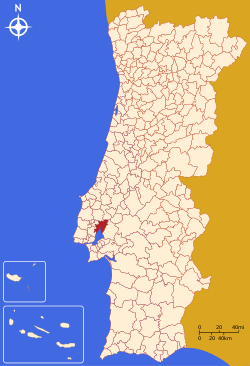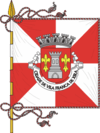Vila Franca de Xira
| Vila Franca de Xira | |||
|---|---|---|---|
| Municipality | |||
| |||
 | |||
| Coordinates: 38°57′N 8°59′W / 38.950°N 8.983°WCoordinates: 38°57′N 8°59′W / 38.950°N 8.983°W | |||
| Country |
| ||
| Region | Lisbon | ||
| Subregion | Grande Lisboa | ||
| Metropolitan area | Lisbon | ||
| District | Lisbon | ||
| Parishes | 6 | ||
| Government | |||
| • President | Alberto Mesquita (PS) | ||
| Area | |||
| • Total | 318.19 km2 (122.85 sq mi) | ||
| Population (2011) | |||
| • Total | 136,886 | ||
| • Density | 430/km2 (1,100/sq mi) | ||
| Time zone | WET/WEST (UTC+0/+1) | ||
| Website |
www | ||
Vila Franca de Xira (Portuguese pronunciation: [ˈvilɐ ˈfɾɐ̃kɐ ðɨ ˈʃiɾɐ]) is a municipality in the Lisbon District in Portugal. The population in 2011 was 136,886,[1] in an area of 318.19 km².[2] Situated on the west bank of the Tagus River, 32 km north-east of the Portuguese capital Lisbon, Vila Franca de Xira is said to have been founded by French followers of Portugal's first king, Afonso Henriques, around 1200.
The town is mostly famous for its bull-running festivals in July and October. Bulls are raised in the salty marshlands of the Ribatejo, which is also a notable breeding ground for the magnificent Lusitano horse, esteemed for its quick reflexes and maneuverability.
A number of brightly coloured Portuguese bullfighting costumes are on display in the ethnographic museum in the town's bullring, the Praça de Toiros (or Touros) Palha Blanco. Nearby, the town's Misericórdia church features striking 18th-century azulejos (glazed tiles). The town also has a Museum of Neo-Realism.[3]
Three km south of Vila Franca de Xira lies the Lezíria Grande Equestrian Centre, where visitors can watch stylish displays of the impressive Lusitano horses. The centre also stages typical bullfighting spectacles in its outdoor bullring. Visitors can ride Lusitano horses and take dressage lessons at the Quinta de São Sebastião, a sprawling estate at Arruda dos Vinhos, 11 km west of Vila Franca de Xira.
The current Mayor is Alberto Mesquita,[4] elected in 2013 as a member of the Socialist Party.[5]
Demographics
| Vila Franca de Xira Municipality (1801–2011) | ||||||||
|---|---|---|---|---|---|---|---|---|
| 1801 | 1849 | 1900 | 1930 | 1960 | 1981 | 1991 | 2001 | 2011 |
| 3 839 | 5 202 | 15 766 | 24 053 | 40 594 | 88 193 | 103 571 | 122 908 | 136 886 |
Parishes
Administratively, the municipality is divided into 6 civil parishes (freguesias):[6]
- Alhandra, São João dos Montes e Calhandriz
- Alverca do Ribatejo e Sobralinho
- Castanheira do Ribatejo e Cachoeiras
- Póvoa de Santa Iria e Forte da Casa
- Vialonga
- Vila Franca de Xira
References
- ↑ Instituto Nacional de Estatística
- ↑ Direção-Geral do Território
- ↑ Museu do Neo-Realismo Archived 2 April 2015 at the Wayback Machine.
- ↑ "Autoridades continuam no terreno a tentar descobrir foco da infeção de 'legionella'" (in Portuguese). Diário de Notícias. Retrieved 12 November 2014.
- ↑ O Mirante (local weekly paper)
- ↑ Diário da República. "Law nr. 11-A/2013, page 552 131" (pdf) (in Portuguese). Retrieved 4 August 2014.
External links
- Official website (Portuguese)
- Photos from Vila Franca de Xira

